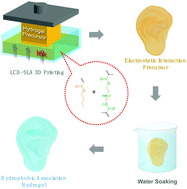Highly stretchable, self-healing, and 3D printing prefabricatable hydrophobic association hydrogels with the assistance of electrostatic interaction†
Abstract
Outstanding mechanical performances and designable architectures are essential for hydrogels when applied as structural materials. In this work, a series of physically cross-linked hydrogels were prepared by copolymerization of a hydrophobic monomer of butyl acrylate and an ampholytic cross-linker of 2-(dimethylamino)ethyl methacrylate and methacrylic acid, followed by soaking in water. The ampholytic cross-linker supported the 3D-printing fabrication of hydrogel precursors, and further hydrated to induce hydrophobic association and caused the transformation from hydrogel precursors to hydrogels. These hydrogels with a water content of 10.4–57.0 wt% possessed excellent mechanical properties, with a tensile strength, elongation at break, and Young's modulus of 61.0–103.4 kPa, 1150–1560%, and 42.7–125.7 kPa, respectively, and meanwhile exhibited fast and high autonomous self-healing ability. This work developed a facile strategy to prepare self-healing hydrophobic association hydrogels besides emulsion polymerization, and offer new ways to construct physically cross-linked hydrogels with designable architectures.



 Please wait while we load your content...
Please wait while we load your content...